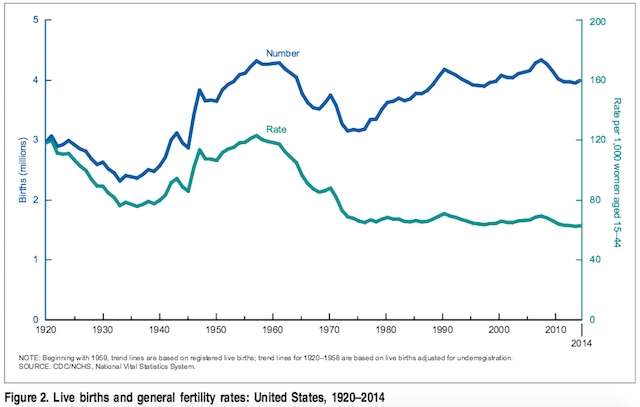Highlights
Perhaps because the National Vital Statistics System, a branch of the CDC, released its latest report over the holidays, its findings about U.S. births in 2014 didn’t hit many headlines. But several of their statistics are worth highlighting.
The biggest news: The general fertility rate rose in 2014 to 62.9 births per 1,000 women of childbearing age, slightly up from a record low of 62.5 per 1,000 in 2013. It’s the first year the fertility rate has increased since 2007, though of course no one knows if the increase will be sustained. Neither the fertility rate nor the raw number of births has recovered from their post-recession declines, as the below figure indicates.

The total fertility rate, an estimate of how many children each woman will have in her lifetime, stood at 1.86 in 2014. That’s a bit below the replacement level of 2.1—the level at which population size will remain constant, barring migration. (Why report multiple measures of fertility? Pew Research Center’s Fact Tank provided a helpful explanation of different measures last year.)
Also notable are several birth-related records that were set in 2014:
- The birth rates of both 15- to 19-year-olds and 20- to 24-year-olds dropped to record lows of 24.2 births per 1,000 women and 79.0 per 1,000, respectively.
- Women’s average age at firth birth reached a record high of 26.3 years.
- Partly because of the trend of delayed childbearing, the twin birth rate set a new record, too: 33.9 twins per 1,000 births. The triplet and higher-order multiple birth rate, by contrast, peaked in 1998 and has since declined.
- The birth rate of unmarried women in their early thirties climbed to a high of 33.4 per 1,000.
In addition, though this isn’t exactly a record, “the number of births occurring at home, 38,094, was the highest since reporting began for this item in 1989,” in the words of the CDC researchers. Still, 98.5 percent of births took place in hospitals.
The overall proportion of births to unmarried women fell to 40.2 percent, the lowest it has been since 2007. The birth rates of unmarried women are on the decline among those ages 15 to 24, but increasing among all older age groups. In fact, counter to the stereotype of young single moms, unmarried 25- to 29-year-olds have had higher birth rates than their 20- to 24-year-old and teenage counterparts since 2011.













